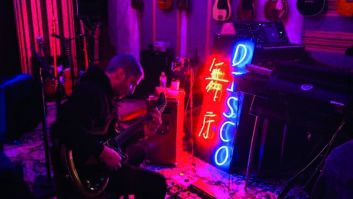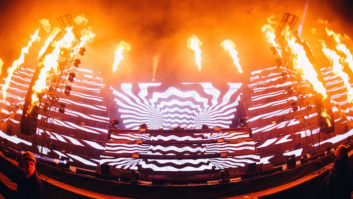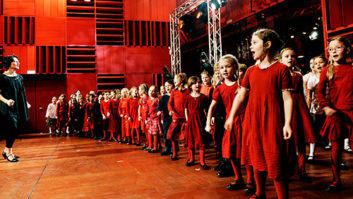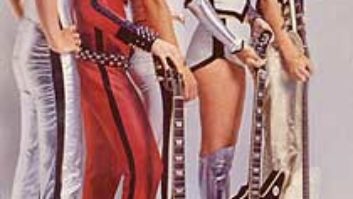Convergence, the meeting of many types of media to form something even more powerful, is always on the move. While the term usually applies to the end product, such as the video iPod or DVD, convergence can also happen on the production end.
If it’s that kind of aligning of the stars that you seek, then check out Wonderland Productions (www.wonderlandnyc.com) in New York City, where the production, direction and editing of film morph extremely easily with the creation of score, sound design and the mixing of same. Founded in 2001 by Emmy Award — winning director Bill McCullough and composer/sound designer John Wiggins, Wonderland is proof that “everything under one roof” works as a creative concept — and is not just a cliché.
“We call ourselves filmmakers; that’s what we do from start to finish, and it really takes advantage of our strengths,” says McCullough from the company’s headquarters at 594 Broadway, a building that serves as a veritable beehive for art, fashion and media activity downtown. “The most exciting thing for us is being the production company, working on the projects from concept to completion.”
While Wonderland attracts its fair share of outside clients, including HBO, NBC, CBS, E!, ESPN and MSNBC, its diverse talent and facilities mean that the facility can also score films, documentaries and series that its creative personnel successfully create and pitch. It all flows from its ability to tightly integrate its own inspiration with a comprehensive in-house production plant: a Pro Tools|HD suite and three Meridian Avid Rooms connected with Transoft shared storage.
The convergence originally stems from McCullough and Wiggins’ shared prowess as musicians and audio engineers. The two met when they both worked in HBO’s production chain in the 1990s. Besides sharing a passion for guitar, they soon found out that they also had compatible business goals. “Things at HBO were getting confining,” McCullough recalls. “We had just been bought by AOL, and we said, ‘How cool would it be to do our own thing?’ I left HBO in 1999, and I had always had a side business with my own clients. John and I were writing so much music, and I would have John write me a couple of cuts when I needed them. We knew we needed a plan to get together, and it snowballed from there.”
Meanwhile, on September 1, 2001, Wiggins accepted a buyout offer from HBO and joined forces with McCullough, not knowing that the business climate was about to get very tricky. “They wanted to get rid of the old-timers, but it meant that my first year in business was financed,” Wiggins says of the package. “I had been at HBO for 20 years, and it was very hard for me, but I did it. Then 11 days later, the world changed. It was strange, but we did okay. We survived.”
Actually, Wonderland thrived, as the duo built a reputation for all-inclusive production with its own distinctive style. From shooting and scoring last year’s award-winning Untold series of sports documentaries for Spike TV to the upcoming Cutting Edge for HBO, which documents the action at a Harlem barber shop, the inspiration starts with McCullough’s trademark shooting and goes from there.
“When we make films, the approach we take is visually different,” explains McCullough. “The angles we use, for example, that all fold in with the music. The advantage we have is that I begin scoring inside my head when I’m thinking what the mood will be, and how I’m shooting will play off of that.”
Wonderland Productions’ John Wiggins (left) and Bill McCullough
photo: David Weiss
The unfolding of the 60-minute Cutting Edge is a good example of Wonderland’s unusually efficient, self-contained workflow. “Every project’s different, but generally there’s two scenarios,” says McCullough. “One is when somebody buys our ideas, like Cutting Edge, or two is a work-for-hire where a network calls and says, ‘We want you to do this show.’ Either way, our executive producer, Dan Klein, is dealing with their executive producer, and once the deal is signed and we figure out what we’re producing here, budgets go into effect.
“While that’s happening in the back office, John and Dan and I are figuring out what we’ll shoot,” he continues. “Then the question comes up about two weeks before the edit what kind of music we’ll use, although usually while we’re shooting we get the sense of what it should sound like. Then the footage is logged, transcribed and digitized as we get it into the Avid. All along, John and I are making music for the project coming up, stockpiling the arsenal, so when the edit comes, I’ll have 50 tracks to use for this project.”
The fast-paced creation of the musical score is aided by the fact that Wiggins is constantly creating tracks for what amounts to an internal library for McCullough to tap during the editing phase, working primarily with guitar, a Korg Karma and 01W, and some adventurous effects plug-ins. “When I don’t have a specific assignment, I’m always making pieces that have no use at the moment or that we know we might use downstream for something else,” Wiggins says. “I’ll compose 20 pieces, mix them, then put them in the library, and I won’t even remember them! Bill and the editors work with the library every day, so they know what’s in there and they’ll remember a cut and say, ‘This one is perfect.’ We have over 1,000 tracks, and they’re simply organized alphabetically by year — 2004, 2005, et cetera.”
A longtime experimentalist in the field of computer-based audio, Wiggins surprisingly makes little use of soft synths. Instead, he enjoys creating many of his moody, dramatic underscores by taking a composition and then completely transforming it with the application of key effects. “My favorite plug-ins right now are from GRM,” he reveals. “In the late ’90s, those guys were on the cutting edge of new computer music and sound dispersion, and what the GRM Tools plug-ins let you do is unbelievable. You can morph the formants and change the music into something totally else, interacting with the music as it’s going by. They’re filters and they sound very simple, but sonically, they are a very important tool.”
To Wiggins, the art of sound design is equally fascinating. “Adding the right sounds is like writing notes when you write music,” he says. “If I feel a lull, I’ll put the sound of a car going by or a horn. Certain sounds become thematic throughout the whole process. Like in Cutting Edge, the clippers are a transitional sound to bring you back to reality. Obviously, when I do my job best, no one can tell and it sounds like it was always there. Never make it sound like you added it; make it subtle.”
Musically, Cutting Edge is an example of how Wonderland likes to veer in unexpected directions whenever possible. “If the ‘it seems too normal’ light comes on, we change it,” Wiggins says. “We tried to stay away from the typical hip hop stuff. It leans more toward 1970s funk, because when you think of Harlem in the 1970s, you think ‘uptown, fabulous,’ with some cool funk bass and wah lines. The drums are not hip hop; they’re street beats, some of which came from loops and some we programmed. There’s also some atypical stuff that you wouldn’t think would go that’s ethereal, pensive, drone-y, almost like a modern underscore. It doesn’t really do anything specific, it just sustains the mood.”
According to McCullough, one of the most important drivers hasn’t been the addition of software or hardware, but an executive producer — Dan Klein. “It doesn’t matter how great the stuff that you do is if nobody sees it,” says McCullough. “John and I are constantly making stuff, but it’s a full-time job to establish relationships, make pitches, talk with lawyers and agents. Not only does Dan do that, but he also oversees the projects we work on, he co-wrote a Discovery series, and we’ll edit the films together.
“I’ve been trying to put this piece of the puzzle together for a while, but you have to find the right person,” he concludes. “Dan and John and I developed a great relationship, and there’s a connection at every intellectual level. That’s what Wonderland is all about, what we had in mind when we started out: Let’s check all the egos at the door. You’re allowed to say stupid things, make bad edits and compose bad music. That’s the freedom you have, but that’s how great projects are born.”





